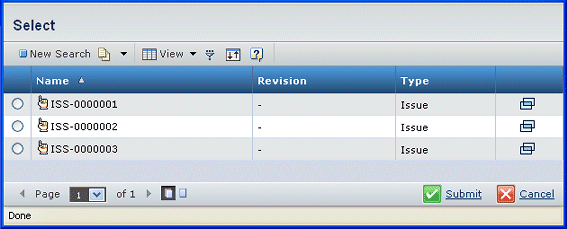Searching Using the Wizard | ||
| ||
Click
 next to the item you are searching for.
next to the item you are searching for.
Or
Click Add Existing from the page Actions menu or toolbar.
Or
Click Add Item from the page Actions menu or toolbar, where Item is what you are searching for (such as Person, Role, or Group).
Or
Click
 > Administration > Search for People.
> Administration > Search for People. The Search page opens, showing fields appropriate to the type of object you are searching for. For example, the following is the Search page when you want to find documents. In some cases, such as when searching for Reference Documents for a Part, you see a Find dialog box. This dialog box works the same way as the Search dialog box.

Depending on the type of item being searched for, you may see additional or fewer fields.
Enter search criteria. By default, all fields are case-sensitive, unless your Oracle database has been configured for case insensitivity. The ENOVIA Live Collaboration/DB2 environments are always case-sensitive.
Field Name How to Enter Values Type Click  to select the type or subtype. Depending
on the page where you initiated the search, you may not be able to change
the type. The list of Common items on the left can contain a number of
types depending on where you initiated the search. Click an item to narrow
the search to that specific Type.
to select the type or subtype. Depending
on the page where you initiated the search, you may not be able to change
the type. The list of Common items on the left can contain a number of
types depending on where you initiated the search. Click an item to narrow
the search to that specific Type.
Name To search for a specific object or group of objects, you can provide a name. Names can include wildcard characters, for example, 001* or *-Version 8. The default is *, which includes all names. Revision Select a Revision option: Latest Released Revisions, Latest Revision; or type a specific revision number or sequence. Revisions can include wildcards, for example, 5-*. For all revisions, use *. Title When searching for documents, you can specify words in the document's title. Description To search for objects that contain a specific word or phrase in the description, type the word or phrase using wildcards. For example, if you are searching for products whose description contains the word machine, you would type *machine* in the text box. This search is not case-sensitive. Owner Click  to select the person who owns the object.
to select the person who owns the object.Originator Click  to select the person who created the object.
to select the person who created the object.Version Check the box if you want to search for versions of the object (if the object allows versioning). Vault Choose one of the options provided, or click  to limit the search to specific vault(s).
to limit the search to specific vault(s).Use the Limit to text box to specify how many items should be shown in the search results. For example, if you limit the results to 50, the system will get only the first 50 items from the database that match your criteria. The maximum is by default 1000, but may vary depending on your installation setup.
When you have finished entering search criteria, click Find.

The title of the dialog box is "Add Existing" or "Select", depending on whether you used an Add Existing menu or toolbar button, or clicked
 in a dialog box.
in a dialog box.The columns that display in the dialog box vary based on the type of object you searched for. You can click any linked item to view the Properties for that specific item.
Use the check boxes in the first column to select items to add. If you are allowed to choose only one item, you will see buttons rather than check boxes.
If the search results do not contain the item you want, click New Search from the page toolbar to change some or all of the previously-specified search criteria.
When searching for companies to be collaboration partners, the search results page contains a Next button where you can select share types, that is, object types for each organization to collaborate on. For details, see Editing Share Types.
Click Submit or Done.
If you used Add Existing, the Search function adds your selection to the list on that page.
If you used
 , the Search function adds your selection
to the field on the dialog box.
, the Search function adds your selection
to the field on the dialog box.If the search results do not contain the item you want, click New Search from the page toolbar to change some or all of the previously-specified search criteria.